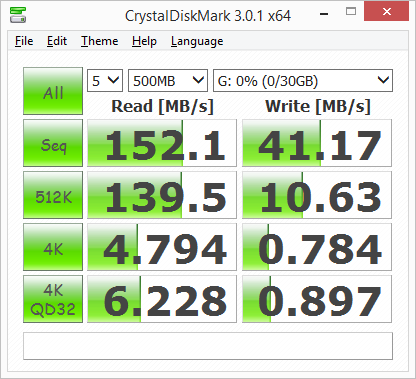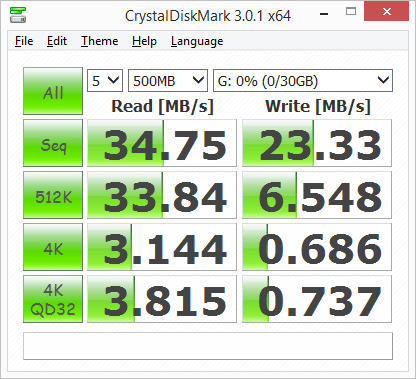Performance:
The test system used in this review was an HP 8200 Elite. The computer is equipped with an Intel Core i5-2400 CPU, 4GB of DDR3 1333MHz memory, Seagate Barracuda 7200.12 ST3250312AS 250GB SATA 6 Gb/s hard drive, NVIDIA Quadro FX580 512MB PCIe graphics card, Intel 82567LM-3 gigabit network card and Patriot SuperSpeed USB PCIe host card. For the operating system, I installed a fresh copy of Windows 8.1 Enterprise.
To test the performance of the Lexar JumpDrive M20 Mobile, I ran a series of benchmarks using CrystalDiskMark 3.0.1, HD Tach RW 3.0.4.0 and ATTO Disk Benchmark 2.46. To get a feel for the "real world" performance, I also copied and pasted 500MB of random files and directories in Windows Explorer.
CrystalDiskMark 3.0:
First, I ran a few quick tests using CrystalDiskMark. This benchmark tool measures the performance of a storage device by testing its sequential read and write speeds as well as its random read and write speeds using blocks 512K and 4K in size.
According to Lexar, the 32GB version of the M20 Mobile is capable of reading at 120 MB/s and writing at 55 MB/s when connected to a USB 3.0 port. While the drive performed better than expected when reading, it came up a bit short of its rated speed in CrystalDiskMark's sequential write test.
HD Tach RW 3.0.4.0:
Next, I used HD Tach to test the M20 Mobile's read, write and burst speeds as well as its seek times and CPU usage.

When connected to the computer's USB 3.0 port, the M20 Mobile had average read and write speeds of 144.4 MB/s and 40.3 MB/s, respectively, as well as a burst speed of 113.8 MB/s. As you'd expect, the drive wasn't nearly as fast when using USB 2.0. Compared to what we saw with USB 3.0, the M20 Mobile's read speed dropped by more than 100 MB/s.
ATTO Disk Benchmark 2.46:
I also used ATTO Disk Benchmark to test the M20 Mobile's sequential read and write speeds. The test was run using blocks ranging in size from 0.5KB to 8192KB and the total length set to 256MB.
When tested with ATTO, the M20 Mobile's read speeds topped out at about 157 MB/s and its write speeds at 39 MB/s.
"Real World" Benchmark:
To test the "real world" performance of Lexar's new flash drive, I copied and pasted 500 MB worth of randomly generated files and directories. All of the files are between 10 bytes and 32MB in size and no more than four directories deep.
| Lexar JumpDrive M20 Mobile - USB 3.0 | Lexar JumpDrive M20 Mobile - USB 2.0 | |
| Write: | 57 seconds | 1:23 |
| Read: | 7 seconds | 21 seconds |
The M20 Mobile performed relatively well here, taking 57 seconds to write our test data and 7 seconds to read it back.
Final Thoughts:
If you have ever tried to transfer a file from one Android tablet or phone to another, you know that it can be a bit of a hassle. For me, this usually meant emailing the files, uploading them to a cloud based service or copying them to my computer using a USB cable. With the Lexar's new JumpDrive M20 Mobile USB 3.0 flash drive, transferring files is now quick and easy. The drive's 2-in-1 design, with both micro-USB and USB 3.0 connectors, lets you move files between your On-The-Go (OTG)-enabled Android devices, or from device to computer, without cables or Wi-Fi. Performance-wise, the M20 Mobile was not the fastest USB flash drive to come through the 'Labs. Nevertheless, the drive performed relatively well in our tests, reading at speeds as high as 157 MB/s and writing at more than 40 MB/s.
The only real complaint I have about the M20 Mobile is its slider. I'm not sure if it's just a poor design or if something happened during the manufacturing process, but the slider on our drive did not work as well as I would have liked. The mechanism wasn't very smooth and was hard to move at times. Also, when the connectors were exposed they didn't always want to lock into place. As a result, the USB connector would get pushed back into the drive when I went to plug it in.
The JumpDrive M20 Mobile is available now in 16GB, 32GB, 64GB capacities. Prices on Amazon.com currently range from $15 up to $50, with the 32GB version reviewed here going for about $26.
Highs:
- Works with On-The-Go (OTG)-enabled Android devices
- Retractable 2-in-1 design with micro-USB and USB 3.0 connectors
- Good read and write speeds
- Backwards compatible with USB 2.0
- Compatible with Windows and Mac systems
- Three year warranty
- Reasonably priced
Lows:
- Slider mechanism is hard to move





